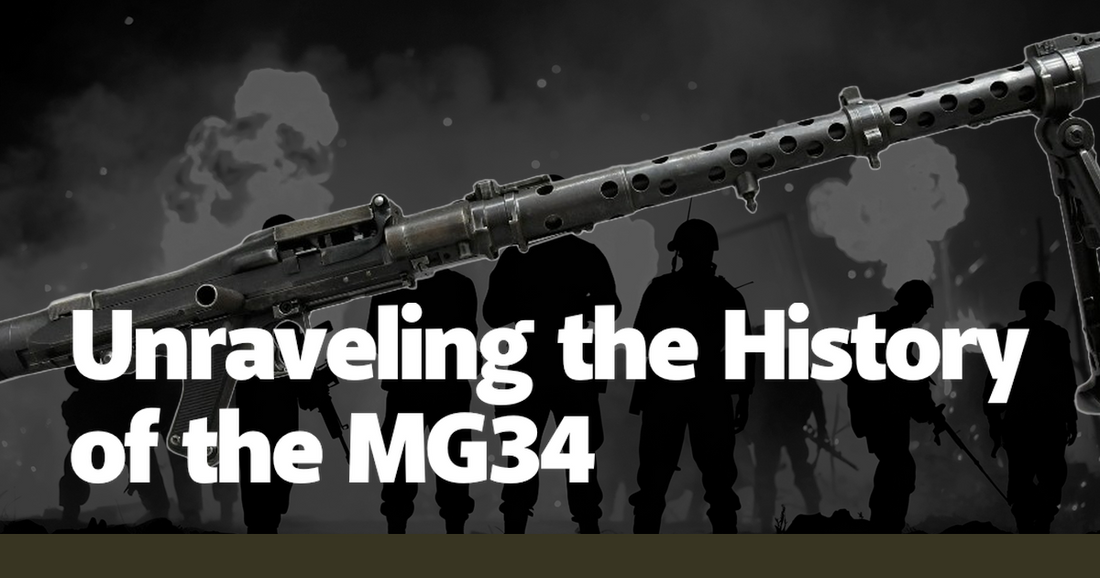The MG34, a machine gun that revolutionized infantry tactics and firepower during World War II, was a marvel of German engineering. Introduced in 1934 by Mauser, the MG34 was the first general-purpose machine gun, designed to be versatile enough for multiple roles on the battlefield. Its design allowed it to be used as a light machine gun with a bipod, a heavy machine gun with a tripod, or even mounted on vehicles and aircraft. This adaptability gave the German Wehrmacht a significant tactical advantage, allowing them to deploy a single weapon system across various scenarios. The MG34's inception marked a significant leap from the static, cumbersome machine guns of World War I, which were often limited to defensive roles due to their weight and complexity.
The development of the MG34 was driven by the need to modernize the German military, which was still relying on outdated weaponry from the previous war. The Treaty of Versailles had severely restricted Germany's ability to produce new weapons, but the rise of the Nazi regime in the early 1930s led to a clandestine rearmament program. The MG34 was one of the first products of this effort, embodying the regime's emphasis on technological superiority and military innovation. Its introduction coincided with the Wehrmacht's shift towards more mobile and flexible tactics, a departure from the trench warfare that had characterized World War I. The MG34's ability to deliver sustained, accurate fire made it an ideal tool for these new strategies.
One of the most remarkable features of the MG34 was its rate of fire, which could reach up to 1,200 rounds per minute. This was achieved through a recoil-operated mechanism that allowed for rapid cycling of rounds. The gun was chambered for the 7.92×57mm Mauser cartridge, a powerful round that provided significant stopping power. The MG34's quick-change barrel system was another innovative feature, allowing gunners to replace overheated barrels in the heat of battle quickly. This was crucial for maintaining the weapon's high rate of fire without risking damage to the barrel or a catastrophic failure. The MG34 also had a relatively lightweight design for a machine gun of its era, weighing around 12 kilograms without ammunition.
The MG34 saw extensive use in various theaters of World War II, from the deserts of North Africa to the icy steppes of the Eastern Front. Its performance in these diverse environments showcased its reliability and versatility. In North Africa, the MG34's ability to function in harsh, sandy conditions was a testament to its robust design. Stories from veterans highlight how the weapon could continue to operate even when clogged with sand and debris. On the Eastern Front, the MG34's high rate of fire was invaluable in the brutal close-quarters combat that characterized much of the fighting. German soldiers often described the MG34 as a "buzz saw" due to the distinctive sound of its rapid-fire, a sound that struck fear into the hearts of their adversaries.
Despite its many strengths, the MG34 was not without its flaws. Its precision engineering made it expensive and time-consuming to produce, a significant drawback as the war dragged on and Germany's industrial capacity was stretched to its limits. The weapon's complexity also made it prone to malfunctions if not properly maintained, a challenge in the harsh conditions of the front lines. These issues led to the development of the MG42, a simplified and more cost-effective successor that retained many of the MG34's best features while addressing its shortcomings. However, the MG34 continued to see service throughout the war, a testament to its enduring effectiveness.
The MG34's legacy extends beyond World War II, influencing the design of post-war machine guns around the world. Its concept of a general-purpose machine gun capable of fulfilling multiple roles has been adopted by numerous militaries. The MG3, a direct descendant of the MG34 and MG42, remains in service with the German Bundeswehr and other armed forces to this day. The principles of versatility, high rate of fire, and quick-change barrels pioneered by the MG34 are evident in many modern machine guns, underscoring the lasting impact of its design. The MG34's influence can also be seen in the doctrine and tactics of modern infantry units, which continue to emphasize the importance of flexible, mobile firepower.
The story of the MG34 is also a story of the men who wielded it. German machine gunners, known as "MG-Schützen," were highly trained specialists who played a crucial role in the Wehrmacht's infantry tactics. These soldiers often formed the backbone of their units, providing suppressive fire that allowed their comrades to maneuver on the battlefield. Anecdotes from veterans reveal the deep bond that many gunners formed with their weapons, treating them with a level of care and respect akin to that of a craftsman and his tools. The MG34's reliability and firepower gave these soldiers a sense of confidence and security, knowing they had one of the best weapons of the era at their disposal.
In reflecting on the history of the MG34, it is clear that this weapon was more than just a piece of military hardware; it was a symbol of the technological and tactical innovations that defined the early years of World War II. Its introduction marked a turning point in the evolution of machine guns, setting new standards for versatility and performance. The MG34's legacy is a testament to the ingenuity of its designers and the skill of the soldiers who used it. As we continue to study and understand the history of military technology, the MG34 stands out as a key milestone, a reminder of how innovation can shape the course of history.

